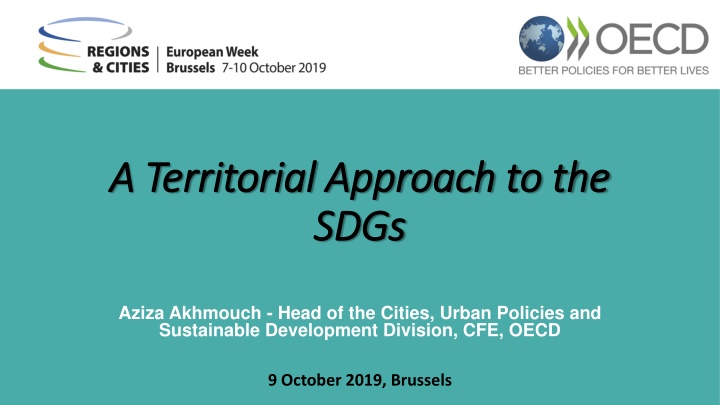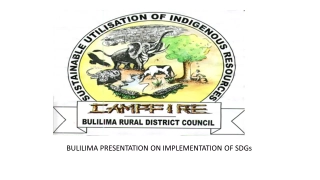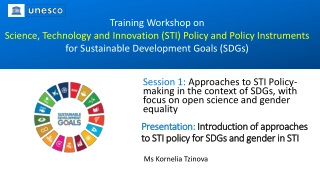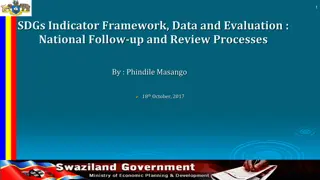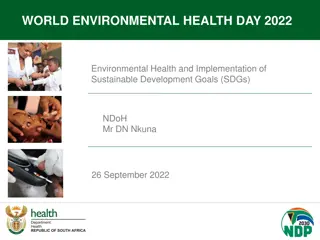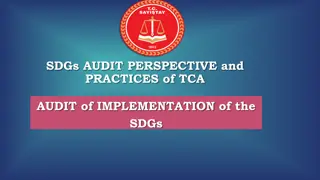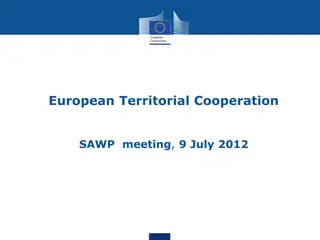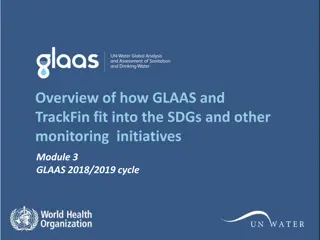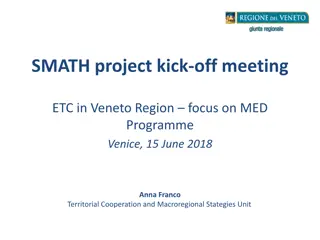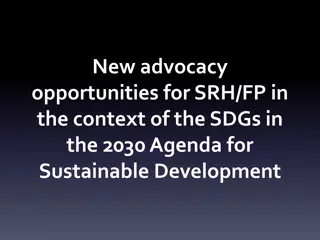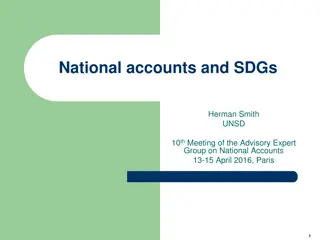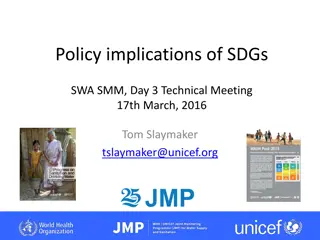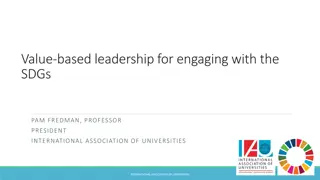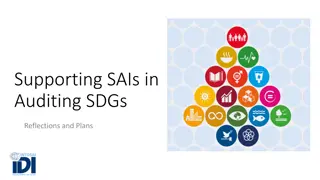Territorial Approach to SDGs: Policies, Actions, and Challenges
Highlighting the OECD program's tailored indicator framework for SDGs, the key contributions of regions and cities to sustainable development, sectoral priorities, and challenges faced in SDG implementation. Insights from various regions and cities shared through peer-to-peer dialogue and policy recommendations.
Download Presentation

Please find below an Image/Link to download the presentation.
The content on the website is provided AS IS for your information and personal use only. It may not be sold, licensed, or shared on other websites without obtaining consent from the author.If you encounter any issues during the download, it is possible that the publisher has removed the file from their server.
You are allowed to download the files provided on this website for personal or commercial use, subject to the condition that they are used lawfully. All files are the property of their respective owners.
The content on the website is provided AS IS for your information and personal use only. It may not be sold, licensed, or shared on other websites without obtaining consent from the author.
E N D
Presentation Transcript
A Territorial Approach to the A Territorial Approach to the SDGs SDGs Aziza Akhmouch - Head of the Cities, Urban Policies and Sustainable Development Division, CFE, OECD 9 October 2019, Brussels
The OECD Programme Measuring A tailored, consensual and localised indicator framework Harmonised and comparable OECD territorial statistics for SDGs Common OECD/EU definition of city and region Learning Analyse & discuss local SDGs stories/evolving practices Draw lessons in terms of incentives, processes, outcomes Pilot-test the indicator framework in different contexts Sharing Peer Peer-to-peer dialogue between cities, regions and national government Twinning during field trips and missions Engagement of umbrella/city networks and stakeholder groups Policy Recommendations County of Viken | Norway Province of C rdoba | Argentina City of Kitakyushu | Japan City of Moscow| Russian Federation State of Paran | Brazil Region of Flanders | Belgium City of Bonn | Germany Region of Southern Denmark | Denmark Municipality of K pavogur |Iceland
HIGHLIGHTS FROM THE OECD HIGHLIGHTS FROM THE OECD- -COR COR SURVEY: SURVEY: THE KEY CONTRIBUTION OF REGIONS AND THE KEY CONTRIBUTION OF REGIONS AND CITIES TO SUSTAINABLE DEVELOPMENT CITIES TO SUSTAINABLE DEVELOPMENT
Policies and Actions Source: CoR-OECD Survey (2019) The key contribution of regions and cities to sustainable development
Sectoral Priorities Source: CoR-OECD Survey (2019) The key contribution of regions and cities to sustainable development
Main Challanges What are the challenges you have faced, or are currently facing, when implementing the SDGs? 0% 10% 20% 30% 40% 50% 60% Lack of awareness, support, capacities or trained staff Difficulty to prioritise the SDGs over other agendas Insufficient financial resources Difficulty to work across levels of government Difficulty to work across departments Lack of information Other No Answer Ratio (Multiple answers possible) Source: CoR-OECD Survey (2019) The key contribution of regions and cities to sustainable development
KEY FINDINGS FROM THE PILOTS KEY FINDINGS FROM THE PILOTS SDGs as a tool for strategic visioning, planning and budgeting SDGs as a framework to manage trade-offs across sectoral policies SDGs to engage the private sector and civil society beyond CSR Need for a comparable and localised SDGs indicator framework
SDGs as a Tool for Strategic Visioning, Planning and Budgeting Three main trends: Using the SDGs as a checklist for ongoing programmes and activities (e.g. Moscow); Adapting existing strategies and plans to the SDGs (e.g. Flanders, Cordoba, Parana); Developing new plans and strategies though the SDGs (e.g. Bonn, Southern Denmark, Kitakyushu, Kopavogur, Viken). The new Regional Development Strategy (2020-23) of Southern Denmark Key SDGs for the sustainability strategy of the city of Bonn Source: OECD elaborations, 2019 Source: Regional Development Strategy of Southern Denmark, 2019
SDGs as a Tool to manage sectoral trade-offs Approaches to horizontal coordination through the SDGs in the OECD pilot cities and regions Matrix to measure synergies between social and environmental/economic SDGs targets in the province of Cordoba Horizontal coordination approach OECD Pilot Project and Steering Groups set up with representatives from all city departments to input to the development of the local sustainability strategy, which implements priority SDGs. It remains unclear if this structure will be institutionalised beyond the strategy development Inter-ministerial Roundtable of awareness and adaptation of the SDGs set up, coordinating all the provincial departments that are developing the processes of prioritisation and alignment of their policies to the targets and goals (Ministries, Secretariats and Agencies) New governance model based on transition principles: system innovation, taking a long-term perspective, involving stakeholders through partnerships, engaging in co-creation and learning from experiments The model is organised around transition spaces managed by teams composed of transition managers from the public administration, responsible ministers and external stakeholders Bonn (Germany) C rdoba (Argentina) Flanders (Belgium) Kitakyushu SDGs Headquarters, SDGs Council and SDGs Club to ensure both horizontal coordination and multi-stakeholder engagement in the implementation of the SDGs Future City Plan Steering Group set up for the development of the local strategy with all heads of department, while the strategy s Project Group coordinates the contents and strategic action plans by all departments to implement the Kitakyushu (Japan) K pavogur (Iceland) strategy Southern Denmark (Denmark) Viken (Norway) An interdisciplinary working group has been set up to identify how the SDGs can be integrated in regional development New county organisation built on the SDGs, where the goals become a new management responsibility and part of everyone s daily tasks and routines Source: OECD elaborations, 2019 Source: pilot report of Cordoba, 2019
SDGs to engage private sector and civil society How can the public sector support private sector engagement with SDGs? Involvement of civil society in SDGs strategies and actions in OECD pilot cities and regions Promoting platforms for coordination, in particular with SMEs (e.g. Cordoba, Bonn) How is civil society involved in the city or region s work on SDGs? Participation by CSOs in the project working group for the sustainability strategy to input and feedback on the strategy contents Open Government Roundtable as a forum to engage multi-stakeholder dialogue Need for better coordination of CSOs actions towards the SDGs Transition spaces and strategic advisory councils provide formal spaces and mechanisms for consultation and collaboration between stakeholders, including CSOs Civil society platform Perspective 2030 lobbying for strong accountability by all OECD Pilot De-risking private investments for innovative SDGs projects (e.g. Viken) Sustainability as a competitive advantage, but need for willingness to pay by customers (e.g. Denmark) Bonn (Germany) C rdoba (Argentina) Key role of sustainablepublic procurement (e.g. Parana, Southern Denmark) Flanders (Belgium) governments SDGs Council and SDGs Club open to CSOs and local citizens Long tradition of civil society as pro-active change agents in the city Involvement of civil society in the strategy development was limited at the initial stages Participatory budgeting initiative (OKKAR) will be linked to the SDGs and new online Kitakyushu (Japan) SDGs Council to engage local stakeholders in Kitakyushu (Japan) K pavogur (Iceland) tools for participation are being developed Citizen Southern Denmark (Denmark) Viken (Norway) Collaboration between civil society and municipalities to foster integration of asylum seekers and long-term unemployed Involvement of CSOs and local citizens as formal requirements of the Regional Planning Strategy process Partnership Source: OECD elaborations 2018 Government Private sector Source: Kitakyushu City the SDGs Report 2018
OECD Localised Indicator Framework Around 117 indicators that allow monitoring progress in 60 out of the 103 targets identified as very relevant for OECD regions and cities (in progress) % 100 88 86 90 83 80 67 67 67 70 63 60 60 56 60 50 50 50 50 40 33 29 25 30 20 20 10 0 Goal 16 Goal 10 Goal 17 Goal 11 Goal 15 Goal 13 Goal 12 Goal 14 Goal 9 Goal 6 Goal 8 Goal 3 Goal 1 Goal 7 Goal 4 Goal 2 Goal 5 % of subnational Targets with at least one available indicator, by Goal
OECD Localised Indicator Framework: some results Distance of OECD Regions to the end values for 2030, by Goal Share of Regions that have not achieved the end values for 2030, by Goal Source: OECD, 2019 Source: OECD, 2019
